The figures made from paper can be different.. However, most often preference is given to geometric figures. One of these is the icosahedron (a development for gluing), which can be called both complex and simple. Complex, because it has many faces - 20 pcs., while it has even more edges - 30 pcs. Simple, because it is completely symmetrical relative to its center.
Description of the figure
The icosahedron (the pattern for gluing is given below in the article) is a figure that got its name about 100 years ago. It comes from the ancient Greek numeral "ikosi", which is translated as "20". The other part of the name is a derivative of the word "hedra", which means "edge". It turns out that the name can be translated from Greek as "20-sided".
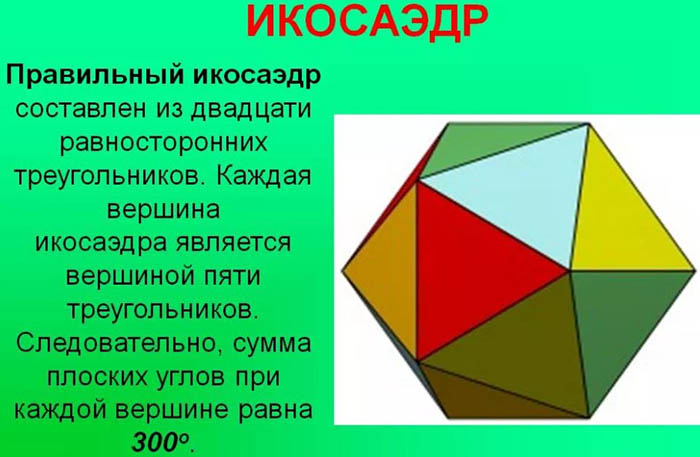
In order for a three-dimensional geometric body to be called a regular icosahedron, it must meet the following conditions:
- it must have exactly 20 faces (no more and no less);
- each of these faces must be a regular triangle. A regular triangle in geometry is one in which all angles are equal. Each angle of this triangle has a value of 60 degrees.
The icosahedron is a regular polyhedron and is one of the five so-called “Platonic” solids.
Its other characteristics are as follows:
- the number of sides of each of the 20 faces is 3;
- number of vertices (points of connection of sides of faces) – 12;
- the number of edges (sides of faces) converging at each vertex (point) is 5;
- total number of ribs – 30;
- number of symmetry axes - 15;
- number of planes of symmetry – 15.

However, all these characteristics follow from the 2 main ones mentioned above. If the figure has 20 faces and if each such face is a regular triangle, then it will already be a real regular icosahedron with all its properties.
Icosahedron (the unfolding for gluing is not difficult even for beginners) is a figure whose area is easy to determine, despite the large number of faces. In addition, it can be represented as the area of the unfolding. If the area of 1 of the 20 triangles that are the faces of the figure is known, then it will be enough to multiply this number by 20.
For example, if the area of each triangle is 4 sq. cm, then the total area of all surfaces of the icosahedron will be 80 sq. m. To do this, 4 must be multiplied by 20.
Main types
The icosahedron that can be made from paper can be different.
For example, if:
- If you use only one color of paper in your work, the figure will turn out to be one-color;
- it will be colored paper, you can make a multi-colored icosahedron, which will play with different colors and look more beautiful.
Often, an icosahedron is made, which looks like a soccer ball in color, with white triangles alternating with black ones. In reality, it will not be a ball, since it is far from round. More difficult to make is an icosahedron, which has the shape of a star. Here, there are already edges that protrude against the background of others.
The most beautiful is the icosahedron, decorated with various decorative elements. These can be any decorations: something shiny, bright - something that can be easily attached to the surface of the paper. Such an icosahedron can be used as a New Year's toy and hung on the Christmas tree.
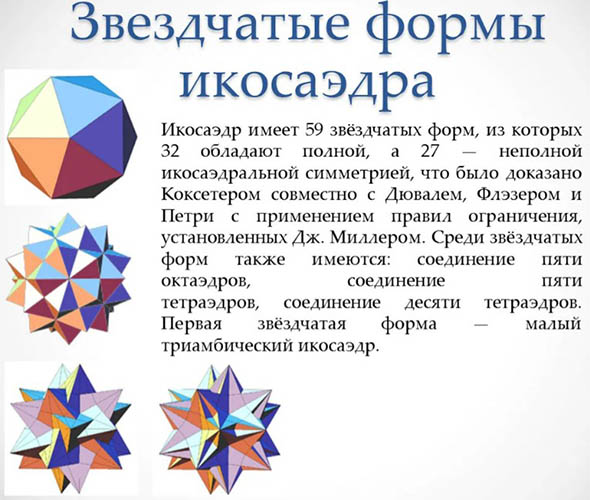
There are countless icosahedra in geometry. Some of them have more symmetries, while others, on the contrary, are less symmetrical. The most common is the regular icosahedron - the one with exactly 20 identical faces. In mathematics, a regular icosahedron can be called both a convex and a non-convex body.
In any case, each of them has 20 faces and 1.5 times more edges. Both have the so-called ixosahedral symmetry. However, the regular icosahedron is often called its convex variety, while the non-convex form falls into the category of great icosahedra.
The icosahedron (scan for gluing) can be represented by the following options:
| Figure | Description |
| Convex icosahedron | It has 20 faces and 12 vertices. This geometric solid has a dual polyhedron. It is called a regular dodecahedron. It has 3 regular pentagonal faces around each vertex. |
| Great icosahedron | It has exactly 20 faces, each of which is a regular triangle. However, its vertex is not a 5-gon, but a pentagram. This is why the faces intersect geometrically. When they intersect, no new edges are formed. The dual polyhedron of the great icosahedron is the great dodecahedron. It has three faces concentrated around each vertex, each of which is a pentagon. |
| Stellated icosahedra | If the faces or edges of a polyhedron expand, then when they touch, a star shape is formed. This happens symmetrically, so the resulting body has the same symmetries as the original figures. Coxeter's scientific work "59 Icosahedrons" lists almost 60 stellated varieties of these polyhedra. Many of them have a separate face, in each of the 20 planes. Many other bodies have more than 1 face per plane. They can be formed by merging simpler polyhedra. |
| Pseudoicosahedron | A regular icosahedron that is twisted, causing its symmetry to be reduced. |
| Jessen's icosahedron | If a three-dimensional geometric body has 12 faces, each of which is an isosceles triangle, and these faces are arranged in such a way that they form a non-convex body, then this figure will already be called the Jessen icosahedron (or orthogonal icosahedron). It has right 2-sided angles. One of its features is that it is equidecomposable with a hexagon, each face of which is a square. This means that it can be divided into small polyhedra, and then a hexagon with equal-sized faces can be made from them. Such a hexagon is a cube. |
How to make a regular icosahedron out of paper?
The development for gluing the Icosahedron for manufacturing will require the preparation of the following materials and tools:
- paper. It can be corrugated, white, colored. Its density can also be different;
- scissors. Required for cutting out figures of the required sizes and shapes;
- glue. Regular PVA is best, because it takes a long time to dry, which is enough to eliminate possible errors;
- ruler. Without it, it will be very difficult to bend the paper evenly along the fold line.

You can also use additional materials to decorate your paper craft. It's a matter of taste and imagination.
After preparing all the materials and tools, you can proceed directly to the creative process.
The work takes place in the following stages:
- Print the finished template on a printer and transfer it to the prepared material. When transferring, you need to be careful. Otherwise, the markings will be incorrect, which means that the figure as a whole will be uneven or nothing will come out at all. It is strongly recommended to use a ruler.
- Start cutting out the template. The scissors must pass strictly along the dotted lines. Otherwise, it will not be possible to glue all the elements of the figure together. At the same time, do not rush, because the template can be easily damaged by careless movement. It is important that all triangular elements of the template have equal sides. This is one of the main properties of the icosahedron. It is as important and obligatory as the condition that all sides of the same square are always equal. If this rule is violated, the difference in sides will be very noticeable.
- After cutting out the blank, start bending the figure. Here you will definitely need a ruler. The folds will be shown as solid lines, and the gluing should be done along the dotted lines. The main goal is to correctly connect all the faces of the triangular elements of the figure. If for some reason you do not have PVA glue at hand, and instead you have a quick-drying adhesive, then you should remember that there is no right to make a mistake. If you connect the parts incorrectly, and the glue dries in a matter of seconds, then you will no longer be able to separate the elements. If you work with PVA glue, you will need to press hard on each joint. After applying the glue, hold the parts pressed against each other for about 20 seconds.
- Decorate the finished product. For this, you can use paints, markers, pencils, pastels. You can also attach a thread to the finished figure to be able to hang it. Often, such a paper craft is used as a Christmas tree toy for the New Year.
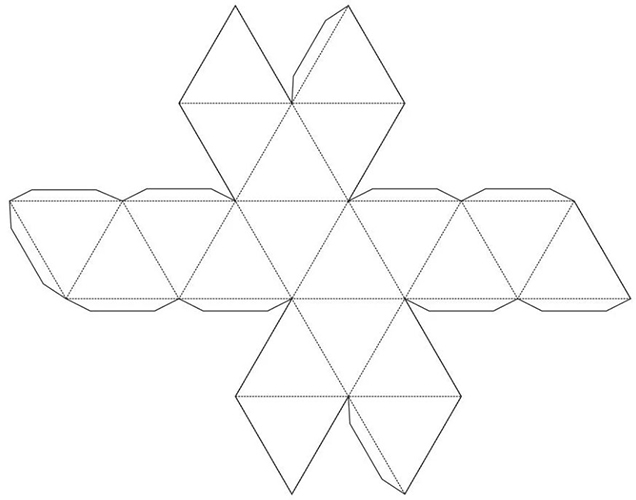
The use of the icosahedron can be different. It can perform not only an aesthetic but also a practical function.
Multicolored icosahedron
The icosahedron (the pattern for gluing can be colored) multicolored can become a good visual aid when studying color shades with the youngest children.
To work on creating a multi-colored icosahedron, you will need the following materials and tools:
- ready-made template (can be easily found on the Internet);
- colored paper (if you don’t have any, you can color white paper with felt-tip pens, paints or pencils, which will be interesting and entertaining for children);
- glue (it is recommended to use long-drying PVA);
- scissors.
Once everything is prepared, you can proceed directly to the creation process, which consists of the following stages:
- Make a blank using a stencil. As for the number of different colors, it can be any at the discretion of the person making the craft. However, the more different bright colors there are, the more the child will like such a product. You can take, for example, the main colors of the rainbow. You can add a few more colors or, conversely, remove those that seem unnecessary (for example, it is not necessary for one figure to have both blue and blue).
- Connect all the elements using long-drying PVA glue.
Stellated icosahedron
The stellated icosahedron is one of the most difficult to make. However, the whole difficulty lies in the fact that you need to have a lot of patience. The work will take a lot of time.
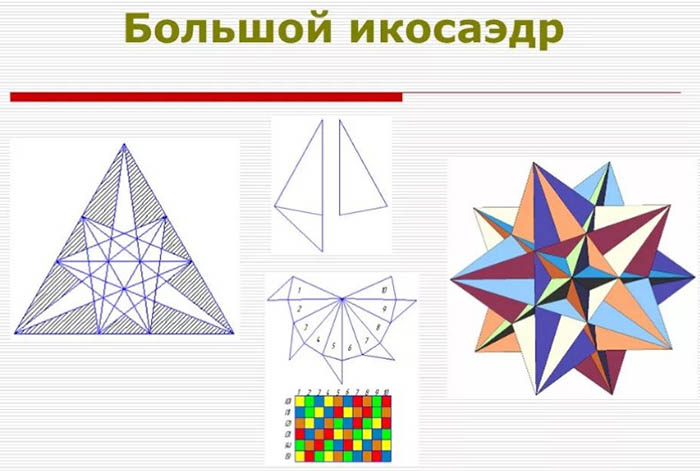
In addition to patience, you need:
- scissors;
- colored paper;
- glue.
You can prepare some decorative elements to decorate the finished product. These can be any objects that seem beautiful: colored threads, ribbons, adhesive beads.
Once everything necessary is prepared, you can proceed directly to the creative process, which consists of the following stages:
- Cut out 30 squares with sides of 5 cm each from the paper. Each such square should have an area of 25 sq. cm. In this case, you should use paper of 3 colors. These can be any tones, for example, green, blue and red. In the end, there should be 10 squares of each color.
- When the required number of squares is cut out, you can take one of them and fold it in half. Then each half needs to be bent to the middle, straightened and folded 2 times opposite corners.
- Make the paper sheet look like a classic tick, which is often made from paper. To do this, fold the large corner from the bottom.
- Take the other side of the square. It should be turned over, then - fold the upper part so that an envelope is formed. In this case, its acute angle should be inserted into the product.
- Continue working with the first square. Now that it has turned into an envelope, you need to fold it in half and roll up the protruding ears, directing them to the outer corners of the triangles. Then, after straightening, an assembly unit is formed.
- Do the longest part of the work: all 5 steps described above should be repeated with each of the 29 remaining squares. This will require a lot of patience. It may not be possible to make all 30 necessary models at once. It is recommended to take breaks in this creative process.
- When all 30 parts are ready, you can take one of them and push its tip into the pocket of another (necessarily of a different color). Accordingly, the corner of this element should fit into the pocket of the third part, which is different in color from the other 2. The corner of the 3rd part should fit into the pocket of the 4th part, which will be the same color as the 1st part. Thus, the colors will alternate.
- Insert the tip of the 3rd piece into the 2nd piece. The 1st piece is inserted into it, and the tip of the 2nd piece is put into the pocket of the first link.
- Insert the 2nd puzzle into the 3rd one, then the 1st one into it, and the whole thing is closed with the 3rd one.
- Assemble all the elements according to the diagram above. As soon as the last element is in place, you can consider the long and painstaking work of making a stellated icosahedron complete.
Decorative icosahedron
A 20-sided geometric body made of paper using the kusudama technique will look great on a festive tree on New Year's Eve. To make a decorative icosahedron, you need to cut out 30 squares from paper. It is best if it is light yellow.
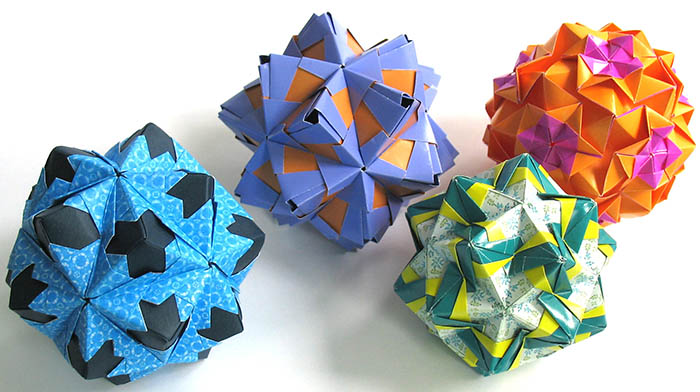
Having prepared the required number of paper squares, you can begin the creative process:
- Take one of the squares (they are all the same, so you can take any one), fold it in half, and bend the sides to the middle.
Then the workpiece is unfolded and then folded along the center line. The edges need to be folded to the center, and then re-opened. - Bend the piece so that the square turns into a triangle. After that, it needs to be straightened, and the side parts should be bent to the center line. Then one of the lower edges should be moved to the side. As a result, a corner should appear. The opposite edge should be bent to the center to form a sharp nose.
- Repeat the entire above procedure once more, but now with the 2nd side of the part. As a result, a square with a pair of triangular-shaped noses is formed.
- The puzzle needs to be folded lengthwise, with one of the two triangles folded forward and the other in the opposite direction.
Next, the part needs to be straightened. To do this, pull its ends. This will create the first link of the decorative icosahedron. However, there should be 30 such links in total, so the procedure is performed 29 more times. - When all 30 elements are ready, you can start connecting them. This is done as follows: the tip of one link must be inserted into the pocket of another; then the tip of the 3rd link is inserted into the same pocket; and the tip of the 4th is threaded into the 5th; then the 1st is inserted into the 5th, as a result of which the ring becomes closed.
- All the tips of the next petal need to be placed in the spaces between the links to form a triangle.
- Each piece should be subjected to a similar procedure. After locking the final triangle, a beautiful figure is formed that will look great on the holiday tree.
Having understood how to make a paper pattern for gluing an icosahedron, you can begin to model it yourself, using a variety of color solutions, materials and decorations.
Video about making an icosahedron out of paper
Master class on making an icosahedron with holes:
